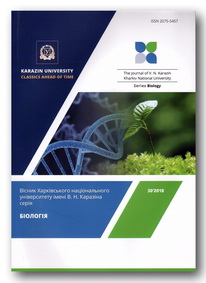Features of floristic structure and productivity of dry meadows of the Left-Bank Forest-Steppe of Ukraine
Abstract
The article presents the results of study of floristic structure and productivity of the dry meadows preserved in the ravine and gully system in the Zmiiv District of the Kharkiv Region. The research was carried out at the model sites with floral composition and features of use typical for the Left-Bank Forest-Steppe of Ukraine. It was established that the total phytocenosis productivity depends on the phytomass fluctuations of two main groups of plants, forbs and grasses. The flora of the studied meadows includes at least 87 vascular plant species. The ten main families altogether number 70 species (80.5 % of the species composition). The families Asteraceae Bercht. & J. Presl (23 species, 26.4 %), Fabaceae Lindl. (11 species, 12.6 %) and Poaceae Barnhart (8 species, 9.2 %) are presented best. This ratio of families is characteristic of herbaceous phytocenoses of the Holarctic floristic realm. The Poaceae family plays the leading role in the formation of meadow phytocenoses, since its members often dominate the main meadow formations. Analysis of the flora ecomorph spectrum revealed prevalence of a xerophilous group that includes meadow, meadow-steppe and steppe species. The obtained data indicate a rather significant xerophytization of the study area, which is typical for the growing conditions of the dry meadows located on the watersheds with atmospheric type of humidification only. Perennial herbaceous meadow-steppe and some ruderal species prevailed in the life form spectrum (77.0 %), which is characteristic of the meadow flora of the Kharkiv Region. Annual segetal weeds, introduced from neighboring fields, contribute significantly to the meadow flora (17.2 %), in particular, such adventive species as Ambrosia artemisifolia L., Amaranthus retroflexus L., and Cyclachaen axanthifolia (Nutt.) Fresen. The research of phytocenose productivity showed that the Poaceae proportion in the meadows with high productivity is usually about 35‒40 %. In the meadows with low productivity, it can exceed 50 % that is explained by the leading role of the family Poaceae in the formation of meadow phytocenoses under high xerophytization of the vegetation cover.
Downloads
References
Balashev L.S., Sipailova L.M., Solomakha V.A., Shelyag-Sosonko Yu, R. (1988). Typology of the meadows of Ukraine and their rational using. Kyiv: Naukova Dumka. 240 p.
Belgard A.L. (1950). Forest vegetation of the southeast of the Ukrainian SSR. Kyiv: Publishing house of Kiev University. 263 p.
Bielyakov S.O., Gofman O.P., Vyshenska I.H. (2017). Modelling the dynamics of total precipitation and aboveground net primary production of fescue-feather grass steppe at Askania Nova according to global climate change scenarios. Biosystems Diversity, 25(1), 16–24. https://doi.org/10.15421/011703.
Biliaev I., Bondarenko H., Harbuz D. et al. (2018). The features of ecological and coenotical composition of the flora of the dry meadows in the vicinity of Haidary village. 13th International young scientists’ conference «Biology: from a molecule up to the biosphere». Abstracts. Kharkiv: V.N. Karazin KhNU. P. 192–193.
Dolynska A., Snisarenko L., Bondarenko H. (2019). Ecological analysis of dry meadow nearby Haidary village (Zmiiv District, Kharkiv Region). 14th International young scientists’ conference «Biology: from a molecule up to the biosphere». Abstracts. Kharkiv: V.N. Karazin KhNU. P. 198–199.
Geobotanical zoning of Ukrainian SSR. (1977). A.I. Barbarych (ed.). Kiev: Naukova Dumka. 303 p.
Lysenko V.F. (1982). The comparative study of the mowned and non-mowned parts of the floodplain of the Severskii Donets river. VIIth Congress of The Ukrainian Botanical Society. Abstracts of the reports. Kyiv: Naukova Dumka.
Mosyakin S.L., Fedoronchuk M.M. (1999). Vascular plants of Ukraine. A nomenclatural checklist. Kyiv: M.G. Kholodny Institute of Botany, NAS of Ukraine. 345 p.
Orlova L.D. (2001). Biodiversity and ecology of the pabular representatives of the Fabaceae family in the meadows of the Poltava region. The Journal of V.G. Korolenko Poltava State Pedagogical University. Ecology series. Biological Sciences, 3(17), 69–76.
Orlova L.D. (2014). The systematic structure of meadow flora in the Left-bank Forest-steppe of Ukraine. Quantitative measures established by families, genera and species of different types of grassland plant communities (riparian, lowland and upland). Issues of steppe forestry and forest reclamation of soils, 43, 7–13.
Taranenko I.Ya. (1946). The vegetation of the forage of Kharkiv suburban zone. Proceedings of the Kharkiv Zootechnical Institute, 4, 174–213.
Tkachenko V.S. (1966). The floodplain meadows of the Siverskii Donets river and their usage. Ukrainian Botanical Journal, 23(5), 95–101.
Tolmachev A.I. (1974). Introduction to plant geography. Leningrad. 244 p.
Yakubenko B.E. (2007). The natural forage of the Forest-Steppe of Ukraine: the flora, vegetation, dynamics and optimization. Abstract of the thesis for the Degree of the Doctor of Biol. Sciences. Kyiv. 47 p.
Yermolenko Ye.D. (1987). The influence of the antropogenetic factors to some of the meadow and forest phytocoenoses of the Sev. Donets river wetland. The Journal of Kharkiv University, 308, 19–22.
Authors retain copyright of their work and grant the journal the right of its first publication under the terms of the Creative Commons Attribution License 4.0 International (CC BY 4.0), that allows others to share the work with an acknowledgement of the work's authorship.




